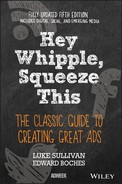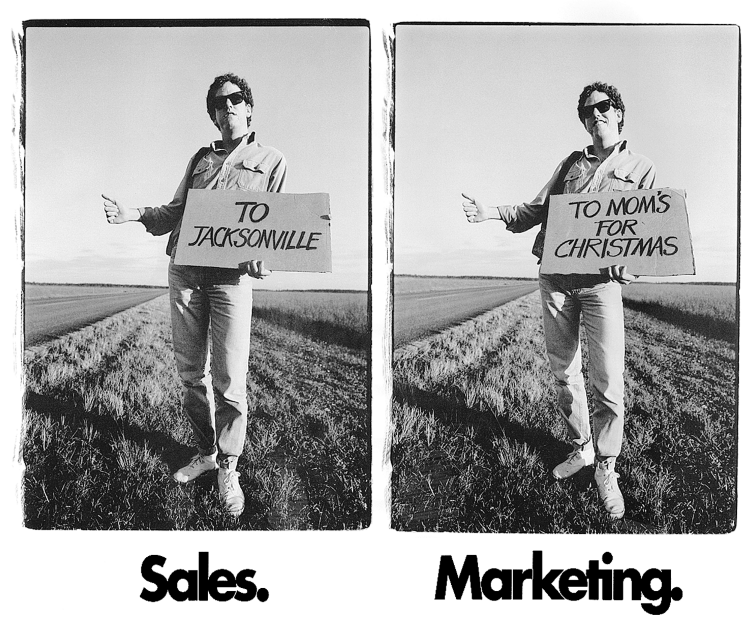
Figure 3.1 This early ad for my friend Alex Bogusky's agency makes a good point. A smart strategy can make advertising perform better.
3
Ready Fire! Aim
Or, What to Say Comes Before How to Say
Before you put pencil to paper, there's some background work to do. You won't be doing it alone, though. You'll have help from the people in account service.
The account folks are the people in charge of an account at an agency. They work with the clients to define opportunities, set budgets and timelines, and do a whole bunch of other stuff. They also help you present the work to the client; and they sell work, too, if you're working with some good ones. Overall, they're the liaison between client and agency, explaining one to the other, running interference, and acting as the marriage counselor when times call for it.
As it is with creatives, some account people are great, some so-so, and some bad. Try to hitch up with the smart ones and get assigned to the accounts they're on. The good ones have the soul of a creative person and genuinely share your excitement over a great idea. They're articulate, honest, and inspiring, and like I said, the good ones have a better batting average at selling your work.
Once you get into the agency business, you'll meet another team member called a strategist. Consider the strategist both a cultural anthropologist and a stand-in for the brand's customer. Strategists analyze the market, study the competition, and basically discover what your brand's customers are doing, how they're doing it, and what devices they're doing it on.
Here's some stuff I've learned from some great account people and strategists I've worked with.
![]()
Remember, You Have Two Problems to Solve: The Client's and Yours
Imagine the circle in Figure 3.2 is the target of what the brand stands for. Any idea you come up with that lands inside this area is perfect. The client will love it. If it's outside the circle, they won't (nor should they).

Figure 3.2 If your idea lands inside the client's brand space, the client will love it. If not, buh-bye.
Okay, now imagine you have two circles that overlap a little. (Figure 3.3).
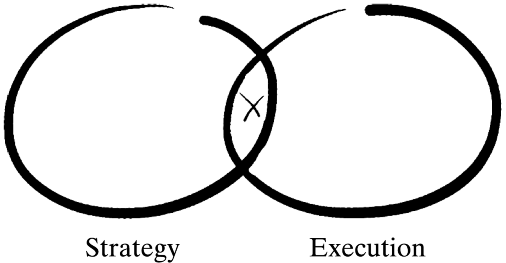
Figure 3.3 If your idea is in only the left circle, it could be boring. If it's in only the right, it might be stupid. Hit the sweet spot, win cash and prizes.
The one on the left is the client's target, and on the right is your target for what you think is a great idea. The trick is to hit that sweet spot where the circles overlap.
You solve the account team's and the client's problem by saying exactly the right thing. That's relatively easy; it's the strategy. But you aren't finished until both problems are solved—until you've nailed the sweet spot. Bernbach said, “Dullness won't sell your product, but neither will irrelevant brilliance.” Here, dullness is represented on the far left side of the left circle, and irrelevant brilliance, on the far right side of the right. In his excellent book Advertising: Concept and Copy, George Felton describes the overlap this way:
As you'll discover when you work on advertising problems, you often lose the selling idea in the act of trying to express it creatively. There is a continual push-pull between being on-strategy and being clever. Each wants to wrestle you away from the other. Your job as a thinker and problem solver is to keep both in mind, to spin the strategy without losing hold of it. As though to indicate this truth, the two most common rejections of your ideas will be “I don't get it” and “I've seen that before.” In other words, either it's too weird or too obvious. That's why the great ones don't come easy.1
The moral? Do both perfectly. Hit the overlap.
Before You Put Pen to Paper
Examine the Current Positioning of the Product or Brand
There's a book called Positioning: The Battle for Your Mind, one I recommend with many caveats. (Although the strategic thinking of the authors is sound, I have many differences with them on the subject of creativity, which they declare irrelevant.)
The authors, Ries and Trout, maintain that the customer's head has a finite amount of space in which to remember products. In each category, there's room for perhaps three brand names. If your product isn't in one of those slots, you must “de-position” a competitor to take its place.
Before you start, look at the current positioning of your product. How do the competitors position themselves? What niches are undefended? Should you concentrate on defining your client's position or do some de-positioning of the competition? Do they have an adjective? (Brand = adjective.) What's your brand's adjective?
Try the Competitor's Product
What's wrong with it? More important, what do you like about it? What's good about the advertising? As Winsor and Bogusky warn in Baked In, “Don't rationalize away what you [like about the competitor's product]. Find the truth they're exploiting that you are not.”2
Then try this trick. In Marketing Warfare, Ries and Trout suggested, “Find a weakness in the leader's strength and attack at that point.”3 A good example comes to mind, again from the pens of's crew. Avis car rental was only number two. So they suggested you come to them instead of Hertz because “the line at our counter is shorter.”
Develop a Deep Understanding of the Client's Business
Bill Bernbach said: “The magic is in the product.…You've got to live with your product. You've got to get steeped in it. You've got to get saturated with it.”4
The moral for writers and art directors is: Do the factory tour. I'm serious. If you get the chance, go. Ask a million questions. How is the product made? What ingredients does it have? What are their quality control criteria? Read every brochure. Read every customer review on their website. You may find ideas waiting in the middle of some spec sheet all ready to be transplanted kit-and-caboodle into an idea. Learn your client's business.
Here's why: Your clients are going to trust you more if you can talk to them about their industry in their terms. They'll quickly find you boring or irrelevant if all you can speak about with authority is Century Bold versus Italic. There are no shortcuts. Know the client. Know the product. Know the market. It will pay off.
Louis Pasteur said, “Chance favors the prepared mind.”
On the Other Hand, There's Value in Staying Stupid
This dissenting opinion was brought to my attention by famous copywriter and educator Mark Fenske. Mark says: “Don't give into the temptation to take the factory tour. Resist. It makes you think like the client. You'll start to come up with the same answers the client does.”
Mark believes, as many do, that keeping your tabula extremely rasa (as it were) makes your thinking fresher. He may be right. There's also this to consider: When you're on the factory floor watching the caps get put on the beer bottles, you're a long way from the customer's backyard reality. All the customer cares about is, “What's in it for me?”
Get to Know the Client's Customers as Well as You Can
Read everything your strategists give you before putting pen to paper. Remember, most of the work you do will be targeted to people outside your social circle, people with whom you have no more in common than being a carbon-based organism.
But don't just read it. Feel it. Take a deep breath and sink slowly into the world of the person you're writing to. Go beyond the stinkin' demographics. Maybe you're selling a retirement community. You're talking to an older person. Someone living on a fixed income. Maybe that person is worried about becoming dependent on his kids. It hurts when he gets out of a chair. The idea of shoveling snow has dark-red cardiac overtones. How does it feel to be this person? Find the emotion.
Find the emotion, and you'll be miles ahead of someone who's just thinking about the brand.
Listen to Customers Talk
Every chance you get to hear what customers are saying, take it. If there's a website or chat room about a product or brand, go there. Eavesdropping is the best way to learn what customers think, and with all the tools now available on the Internet, monitoring public opinion has become too easy not to do it.
Less useful (and usually more infuriating) is to hear what customers are saying about your work in focus groups. God, I hate focus groups. There are probably just two things in the world I hate more than listening to focus groups as they complain about an agency's ideas. (For the record, the two things are [1] sawing off my legs and walking into town on the stumps and [2] kissing the side of a passing train that's covered in sandpaper and then bobbing for cherry bombs in a vat of boiling ammonia.)
Focus groups suck. I'm not the only person who believes describing your idea to people being paid $50 and a Diet Dr. Pepper is a bane on the industry. The good focus groups are the ones customers are doing for free online every day.
Ask Yourself What Would Make You Want the Product
This is a simple enough piece of advice and one I often forget about while I'm busy trying to write an ad. Sit across from yourself at your desk. Quiet your mind. Then ask, “What would make me want to buy this product?”
Then try the flip side: “What would I do if I were the one bankrolling the campaign?”
Imagine a Day in the Life of Your Customer
Let's put our ad-writing pencils down for a minute and think way upstream about our client and the client's customer.
How does our client's typical customer spend a day? What does she do in the morning? Is Pandora playing music while she fixes breakfast, or does she grab something on the go? Does she drive to work? Does she have a tablet; if so, what kind? Does she recycle? What blogs does she read when she's supposed to be working? Does she run at a gym or on the streets, or run like me…into the kitchen for another Krispy Kreme?
This thinking doesn't have to be guesswork. It's likely your agency colleagues have gathered all kinds of good research about the customer. So before you start work on a campaign, it's time to sit down with the account, strategy, and media team and map out a day in the life.
If your campaign has a digital component, it's also time to sit down with the UX person (stands for “user experience”). Your UX person will be a major part of mapping out this day in the life of the average customer's use of media. And when it comes to creating work for online, your UX person will help your team figure out the architecture of the online experience from start to finish. Similar to an architect building a house, a UX person goes through the entire place to make sure things like the correct outlets are on the right walls, that doors are where they should be, and so on; all very important functions but ones that have nothing to do with the idea or the aesthetics of the house, which is the creative's job. Your UX person will start with the same objectives and strategy you do, but will use all that information to frame up the end experience and make it one that's as user friendly and efficient as possible.
As your team begins to explore an average customer's typical day, you may see that newspapers play a part in this person's life, as well as other common media, such as television and radio. But those are the easy ones. We're not making a media checklist here anyway. What we're doing is looking for insight. It's kind of like we're trying to see the aquarium from the inside out, to move through our customers' world exactly the way they do. We're looking for contact points with them that are unexplored. We're looking for places where customers might even welcome a cool message from our brand. Places where the right message could be less of an ad and more like information or entertainment.
A day in the life of a real estate agent is going to be different than a corporate executive's day. A real estate agent practically lives online, and his cell phone rings constantly. The executive probably has people to answer her phone and gets information by listening to podcasts at the gym or reading business pubs on the plane.
Although all this different-strokes-for-different-folks stuff may seem a little obvious, it's surprising how many agencies buy the media before finding the insight, or simply use the same media plan to reach every audience. (“We'll buy TV for reach, magazines for frequency, and throw in a little radio for promotions.”)
During this exercise is also a good time to ask yourself, “What would a generous brand do to get out and meet its customers?” Fallon's John King says generous brands are empathetic and tend to make gestures that are not just commercially motivated; they pay less attention to their own marketing schedules and more to the calendars of their customers, “taking the time to know and understand what's going on in the audience's lives. Brands today should take cues from Google's ever-changing home page, asking how they can participate on St. Patrick's Day or Election Day instead of brainstorming ideas to ‘Drive sales in Q3!’—a concept that has no relevance to the average person's calendar.”
Okay, now before we start writing, there's one other mental exercise that may be helpful.
Imagine the Buying Process
After you've mapped a day in the life with your customer, switch gears. Now think through how a customer decides to buy your client's product. Here again, agency research and insights from your colleagues can help you see the entire buying process through a buyer's eyes.
Some folks call this the purchase funnel, although that term's a little creepy for my money. (In Chapter 14, we'll talk about how purchase funnels are totally different in a digital world.) For now, a funnel will do. Scribble one on a big pad and start visualizing what happens to your customer as he or she moves toward actually buying your client's product. Think it through. How is it that a normal person can move from a state of being perfectly happy living without, say, your client's fabulous flat-screen TV, to noticing the flat screen in the sports bar, to thinking, “Geez, my old TV is kinda crappy,” to swooning in front of all the brands on display at the mall, to checking prices online, to triumphantly swiping his or her VISA card through the machine at Best Buy (or swallowing hard and hitting “Buy now with one click”)? As you go through the process, think about the contact points that pop up—those times a customer might have occasion to think about a flat-screen TV or about the whole home entertainment category in general.
As you might imagine, the consideration process is different for a flat-screen TV than, say, buying a pack of gum, or a car, or insurance. Depending on the product, the process can be long or short; the longer ones typically consist of phases. I'm sort of making up some phases here for a nonexistent product, but a customer could move from general awareness to short-listing to comparison, to store contact, to store visit, to trial. Phases such as these may be useful to keep in mind as you work on your overall idea. Different media will be in play at different parts of the purchase cycle, and each of them has different strengths to leverage.
Here's the thing to remember about this whole exercise: Your main idea may come out of one of these contact points—an idea you can then spread sideways and backward to fill in the whole campaign. Find a cool contact point that leads to an idea, then fan that flame into a big idea, and then take the big idea and turn it into a multimedia experience.
Study the Client's Previous Work
The client or the account executives know where to find it online or in the agency archives. Study it. Maybe the previous agency tried something that was pretty cool, but perhaps didn't do it just right. How could you do it better? This will get your wheels turning as well as keep you from presenting ideas the client's already tried.
Look at the Competitors' Advertising
Each category quickly manages to establish its own brand of boring. Learn the visual clichés everybody else is using. Visit their websites and watch their commercials. Listen to them on Twitter and on Facebook. Creep through the woods, part the branches, and study the ground your competitors occupy. What seems to be their strategy? What's their look? Those schmucks. They don't know what's coming.
Read the Awards Books; Study the Sites
Take a little inspiration from the excellence you see there and then get ready to do something just as great. The best awards shows are the One Show and Communication Arts, as well as the British D&AD annuals. You should also make a weekly visit to some of the newer sites and awards venues: thefwa.com, the Facebook Awards, the Webbys, and the SXSW Interactive awards.
A Few Words on Authenticity
There was a time (the 1950s and early 1960s) when simply running an ad in a magazine made you an authority. (“See, honey, it's printed right here. In a magazine.”) A cigarette ad could actually claim there wasn't “a cough in a car load.” Facts didn't count. Authority did. Pick up an old magazine sometime and see if you don't agree; almost every ad and every article feels like a pronouncement from an authority.
The voice of authority's favorite advertising technique was what some call “inadequacy marketing.” Jonah Sachs, in his excellent book Winning the Story Wars, says inadequacy marketing “stirs up anxiety and then offers [us] an object to quell it.” (Translation: “You're fat and sweaty, so buy this.”) The product was the hero and you were a loser if you didn't buy it now.
Empowerment marketing, on the other hand, emphasizes not where we're deficient but instead appeals to our human desires for personal growth, for fulfillment. Here, says Sachs, the product isn't the hero, only a means to “carry out a human drive to find fulfillment based on our core values.” Think Apple's “Think Different.” Or better, any of the wonderful work from Dove's “Real Beauty” campaign.
Sometime in the mid-1950s, however, this omnipresent voice of authority started to lose its credibility. How this came to be is perhaps a story for another day, but it happened. Now, imagine if you were to run the 1950s Plymouth ad shown in Figure 3.4 in next week's Time magazine. I'll bet even if you updated the ad's look and feel, its presumptuous tone (“Big is glamorous, dammit!”) would still make today's readers snicker at its authoritarian cluelessness. You simply wouldn't get away with it today. Things are different now.

Figure 3.4 This car is great because the manufacturer says it's great, dammit.
We've become a nation of eye-rollers and skeptics. We scarcely believe anything we hear in the media anymore, and marketers can't make things true simply by saying they're true. In The Art of Immersion, Frank Rose writes, “People today are experiencing an authenticity crisis, and with good reason. Value is a function of scarcity, and in a time of scripted reality TV and Photoshop everywhere, authenticity is a scarce commodity.”5 And although real authority certainly continues to exist in places, what people look for today, and what they believe in and are persuaded by, is authenticity.
Merriam-Webster says something is authentic when it actually is what it's claimed to be. This makes authenticity in advertising an especially tricky proposition, given that advertising is at its heart self-promotion and driven by an agenda. And although Americans today are suspicious of anyone with an agenda, being authentic doesn't require the absence of an agenda, only transparency about it.
Some Tactics on Communicating True Authenticity
Admitting your commercial is a paid message with an agenda is one effective way to disarm distrust. Alex Bogusky says, “This generation knows you're trying to sell them something and you know they know, so let's just drop the pretense and make the whole exercise as much fun as possible.”6
Underpromising and overdelivering is another way to disarm distrust. Even self-deprecation can help establish authenticity; VW's “It's ugly but it gets you there” is perhaps the most memorable campaign using this approach. Admitting any kind of weakness may be a counterintuitive way to establish trust, but it is effective. This marvelous ad for a pricey off-road recreational vehicle is candid, admitting it's an indulgence (Figure 3.5) but somehow it makes their argument more compelling.
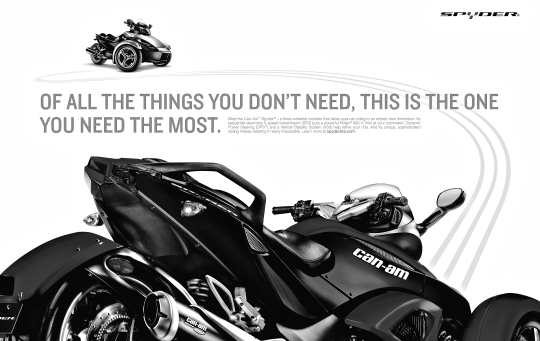
Figure 3.5 When a brand is candid about its weaknesses, somehow it makes everything else they say sound more believable. (From Cramer-Krasselt, Milwaukee)
The stronger version of admitting a weakness is what some call “Embracing the Suck.” Here we take the worst thing about a product and use it to talk about its best thing. In a campaign from Saatchi & Saatchi, Buckley's cough syrup compared its horrible taste to “public restroom puddle” and “spring break hot tub water” before signing off with, “It tastes awful. It works.” whipple5badtaste
Canadian Club's masterful print series (Figure 3.6) is an excellent modern example of an advertiser leveraging reality, warts and all, to sell its wares. An unapologetic statement of “Damn right your dad drank it” coupled with images of 1970s dads—somehow still cool in their bad haircuts and paneled basements—leveraged authenticity instead of authority.
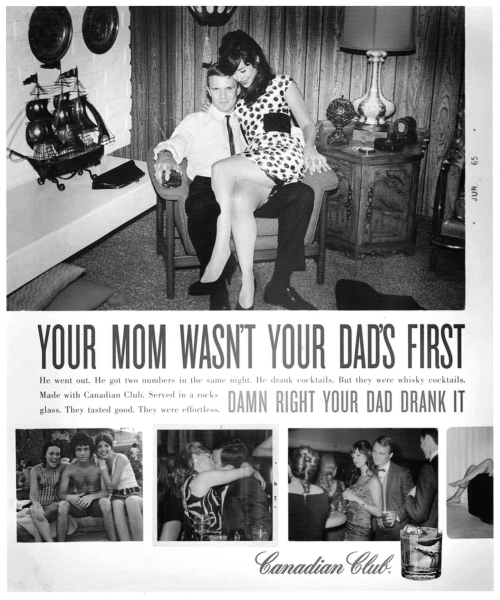
Figure 3.6 Compare this campaign to pretty much every other liquor campaign ever done. I actually believe this one. It's authentic.
One last thing before we leave the subject. In Winning the Story Wars, Sachs lists five ways a brand can be inauthentic—vanity, authority, puffery, insincerity, and gimmickry.
The Final Strategy
The Best Creative People Are Closet Strategists
This, from my friend, Ryan Carroll, CD at GSD&M:
Great creatives are also closet strategists. They can see the opportunities inside of a problem, they study the behavior of their audience, and then combine those two things to create an idea that is persuasive. But 90 percent of the books I see have ill-conceived, poorly thought-out strategies. Here's an example I've altered to protect the innocent.
The client was Fender guitars. The brief's alleged insight was: “Everyone is born with the ability to play music. Often, they just need a friendly reminder.” Okay, half the musicians I hear out there are not born with any musical ability at all and no amount of “friendly reminders” is going to help them.7
Ryan suggests you spend as much time researching the problem as you do on solving it. Spend time finding that insight. “When I read a strategy or insight that floors me,” he added, “the work that follows almost always does the same.”
At ad agencies, these strategies most often come from the strategists, not so much the creatives. But the brief is rarely nailed first time out. It's an evolving thing often torn to pieces during the briefing and beyond. “That's a good thing,” says Carroll. “But it takes a smart creative to critically assess a brief, find those insights, and then make it better.”
Make Sure What You Have to Say Matters
After you finish, look at your work and ask yourself two questions. One is, “Oh yeah?” The other is, “So what?”
The rebuttal to “Oh yeah?” is having a claim that's incontestable. The answer to “So what?” is making sure your idea is relevant. It must matter to somebody, somewhere. It has to offer something customers want or solve a problem they have, whether it's a car that won't start or a drip that won't stop.
If you don't have something relevant to say, tell your clients to put their wallets away. Because no matter how well you execute it, an unimportant message has no receiver. The tree falls in the forest. Crickets chirp.
Insist on a Tight Strategy
Creative director Norman Berry wrote: “English strategies are very tight, very precise. Satisfy the strategy and the idea cannot be faulted even though it may appear outrageous. Many…strategies are often too vague, too open to interpretation. ‘The strategy for this product is taste,’ they'll say. But that is not a strategy. Vague strategies inhibit. Precise strategies liberate.”8
Poet T. S. Eliot never worked at an ad agency, but his advice about strategy is right on the money: “When forced to work within a strict framework, the imagination is taxed to its utmost and will produce its richest ideas. Given total freedom, the work is likely to sprawl.”
Dude nailed it. You need a tight strategy.
On the other hand, a strategy can become too tight. When there's no play in the wheel, an overly specific strategy demands a very narrow range of executions and becomes by proxy an execution itself. Good account people and strategists can fine-tune a strategy by moving it up and down a continuum that ranges between broad, meaningless statements and little, purse-lipped creative dictums masquerading as strategies.
When you have it just right, the strategy should be evident in the campaign, but the campaign should not be evident in the strategy. Jean-Marie Dru put it elegantly in his book Disruption:
There are two questions that need to be asked. The first is: Could the campaign I'm watching have been created without the brief? If the answer is yes, the odds are the campaign is lacking in content. You have to be able to see the brief in the campaign. The second question is a mirror image of the first.…Is the campaign merely a transcription of the brief? If the answer is yes, then there has been no creative leap, and the campaign lacks executional force.9
Ultimately, a good strategy is inspiring. You can pull a hundred rabbits out of the same hat, creating wildly different executions all on strategy. Droga5's magnificent work for Newcastle continues to surprise and delight every year since they established their “No bullocks” strategy in 2012.
Insist on a tight strategy. Will you always get one? No. In fact, in this business tight strategies seem to be the exception, not the rule. But you must push for one as hard as you can.
“Small rooms discipline the mind;
large rooms distract it.”
—Leonardo da Vinci
The Final Strategy should be Simple
Advertising isn't “rocket surgery.” Most people live and think in broad strokes. Like we said earlier, ask some guy in a mall about cars and he'll tell you Volvos are safe, Porsches are fast. Where's the genius here? There isn't any.
You want people who feel X about your product to feel Y. That's about it. We're talking one adjective here. Most of the time, we're talking about going into a customer's brain and spot-welding one adjective onto a client's brand. That's all. DeWalt tools = tough. Coke = happiness.
We'll return to the virtues of draconian simplicity in Chapter 6, but for now it suffices to invoke the classic advice, KISS: Keep It Simple, Stupid. Don't let the people on your team or the client make you overthink it. Try not to slice too thin. Think in bright colors.
The Difference between Strategy and Tactics
Strategy is what we want to happen, and tactics are how we'll do it. Listed below are 10 tactical approaches you can mess around with to get your mental engines started. (And you'll need to get 'em started, because we start concepting in two pages. Yikes.)
- Do a straight-on us versus them approach.
- Show life before and after the product.
- Is there a compelling story about the heritage behind your brand?
- Can your brand dispense some smart advice about the whole category?
- Is there a story in the founders of the brand? Or in their original vision?
- Can you turn a perceived negative attribute of your product into a positive?
- Can you demonstrate on camera or online your product's superiority?
- Can you move your product out of its current category and reposition it in another?
- Can your brand be insanely honest about itself, admitting to some shortcomings while winning on the important thing?
- Instead of trying to change how people think, change what they do.
Okay, now comes the fun part: coming up with cool ideas.
